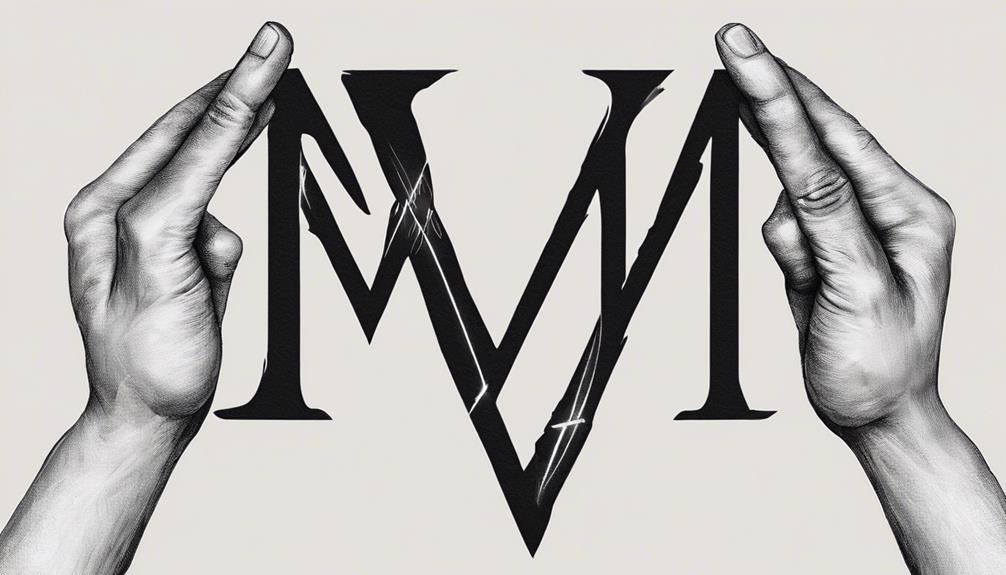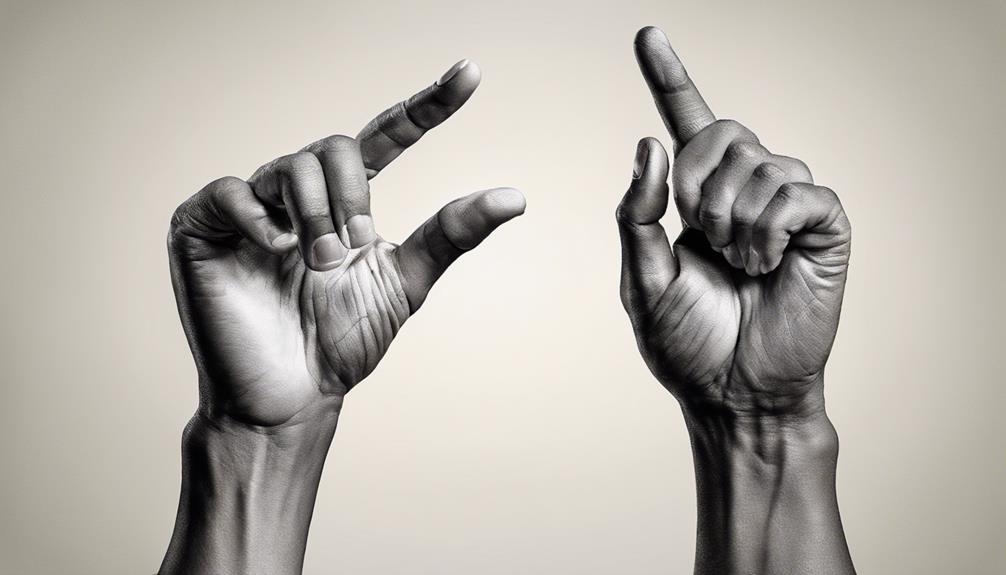Did you know that the ‘M’ sign is one of the most commonly used handshapes in American Sign Language? It plays a vital role in creating numerous words and expressions, making it an essential component to learn in sign language communication.
As we explore the intricacies of perfecting this sign, we uncover tips and techniques that can elevate our signing proficiency to a whole new level. Let's delve into the significance of mastering the 'M' sign and unravel its impact on our signing journey.
Key Takeaways
- Practice handshape and movement precision for clear M sign communication.
- Incorporate M sign in common words like 'Mom' to enhance ASL vocabulary.
- Utilize practice exercises and visual aids to master the M sign fluency.
- Engage in interactive ASL resources and seek feedback for continuous improvement.
Importance of the 'M' Sign
Mastering the 'M' sign in American Sign Language (ASL) is pivotal for effectively expressing words and concepts that commence with the letter M. The 'M' sign holds significance in ASL communication as it helps convey specific meanings with clarity and precision. Understanding the finger movements and hand positioning for the 'M' sign is crucial for accurate signing. It's essential to note that the 'M' sign is typically performed with the dominant hand, ensuring consistency and fluency in signing. By practicing the 'M' sign regularly, individuals can develop muscle memory and proficiency in using this sign fluidly during sign language interactions.
The 'M' sign plays a vital role in spelling words and expressing ideas that start with the letter M. Mastering this sign enhances communication clarity and fluency in ASL conversations, enabling smoother interactions. Proper execution of the 'M' sign involves precise movements and hand placement to accurately represent the letter M. Through dedicated practice and attention to detail, individuals can improve their signing skills and effectively incorporate the 'M' sign into their communication repertoire.
Correct Handshape and Movement

The correct handshape for signing the letter M in American Sign Language involves curling the fingers into the palm with the thumb tucked between the pinky and ring finger. To master this sign, it's crucial to pay close attention to the specific positioning of the pinky and ring finger. Additionally, the movement for signing M includes creating humps using the knuckles of the pointer, middle, and ring fingers. Visualizing the cursive letter M can be a helpful technique in forming the sign accurately. Practice plays a vital role in perfecting the hand movements necessary for signing the letter M in ASL. Understanding the precise finger positioning and movements is key to mastering the M sign effectively.
| Finger Position | Movement | Practice |
|---|---|---|
| Pinky & Ring | Humps with Knuckles | Essential |
Common Words Using the 'M' Sign
Exploring everyday vocabulary incorporating the 'M' sign in American Sign Language enhances fluency and communication skills. Words like 'mom,' 'more,' and 'music' utilize the 'M' sign in ASL. Understanding these common words not only enriches vocabulary but also improves proficiency in sign language.
By practicing signing 'M' within daily phrases, individuals can enhance their fluency and practical application of ASL in various interactions. Recognizing and using words that incorporate the 'M' sign provides a solid foundation for expanding one's sign language knowledge and expression.
Incorporating these common words seamlessly into conversations allows for a smoother and more efficient way of communicating in sign language. Mastering the usage of the 'M' sign in these everyday words is a fundamental step towards becoming more proficient in ASL and fostering better communication with the deaf community.
Practice Exercises for Mastery

In honing our sign language skills, we can enhance proficiency through targeted practice exercises focusing on mastering the 'M' sign.
To effectively sign the letter M, concentrate on forming the three humps that mirror its written representation. Utilize visual aids such as flashcards or images depicting the cursive letter M to reinforce the correct hand movements.
Repetitive practice sessions are crucial for building muscle memory and improving signing accuracy. Engaging in interactive platforms like Sign Tribe Academy can provide guided exercises and valuable feedback on your signing proficiency.
Additionally, incorporating finger exercises and stretches into your practice routine can enhance hand mobility and dexterity, leading to better signing performance.
Tips for Enhancing Sign Fluency

Enhancing sign fluency involves consistent practice and exposure to varied signing styles and contexts. To improve fluency in signing the letter M, consider these tips.
Firstly, practice regularly, focusing on the specific handshape of three fingers extended and the movement that forms the letter M. Visual aids like flashcards or instructional videos can help reinforce proper hand movements.
Seeking feedback from fluent signers or instructors is crucial to correct any errors and refine your signing accuracy. Engage in interactive ASL lessons or workshops to enhance your overall sign language proficiency, as this will contribute to mastering the M sign.
Additionally, joining online communities or groups dedicated to sign language can provide opportunities to practice signing with others and receive support. By incorporating these strategies into your learning routine, you can strengthen your fluency in signing the letter M and in sign language overall.
Frequently Asked Questions
How Do You Do the M in Sign Language?
When signing the letter M in American Sign Language, we tuck our thumb between the pinky and ring finger while curling the remaining fingers into our palm. The knuckles on the pointer, middle, and ring fingers should resemble the humps of the letter M for accuracy.
Visualizing the cursive letter M can assist in forming the sign correctly. Pairing the M sign with the corresponding sound aids in learning and memory retention.
How Do You Sign the I'm Learning Sign?
We start by combining the signs for 'I,' 'learn,' and present progressive tense in American Sign Language to express 'I'm learning.'
First, point to yourself for 'I,' then bring your dominant hand to your forehead and extend it forward for 'learn.'
Finally, use a repeated back-and-forth movement to indicate present progressive tense.
Practicing this sequence helps accurately convey the concept of 'I'm learning' in ASL.
How to Speak Sign Language Fluently?
To speak sign language fluently, we practice regularly and use resources like Sign Tribe Academy for structured learning. Focusing on mastering individual signs enhances overall fluency.
Engaging in conversations with fluent signers provides practical experience, while watching sign language videos and mimicking gestures refines our skills.
How Do You Sign I'm an ASL Student?
When signing, 'I'm an ASL student,' we fingerspell the letter 'I,' use the ASL gesture for 'ASL,' and fingerspell 'student.'
It's essential to transition smoothly between signs for effective communication.
Mastering ASL involves practice and utilizing resources like flashcards or online tutorials to enhance signing skills.
How Can I Master the M Sign in Sign Language for Greeting?
To master the M sign in sign language for greeting, you can learn morning sign language easily through online tutorials or local classes. Practice making the M sign in front of a mirror and use it to greet others in the morning. Consistent practice is key to mastering this sign.
Conclusion
In mastering the M sign in sign language, practice makes perfect.
Remember, 'practice makes perfect' – the more you practice, the easier it becomes to accurately sign the letter M.
Keep up the hard work and dedication, and soon you'll be signing with fluency and confidence.
Stay motivated and never give up on improving your signing skills.
The journey to mastering the M sign is filled with progress and success.











